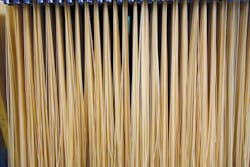When Americans think about Italian cuisine, pasta is one of the first
foods that comes to mind. According to a Datamonitor report, the pasta market in the United States increased at a compound annual growth rate of 6.7 percent between 2003 and 2008. A report on MSNBC.com stated that total U.S. consumption of pasta grew 0.4 percent in 2009, not including numbers from Wal-Mart Stores Inc., where industry officials say the growth was higher.All that pasta has to be manufactured. Not surprisingly, Italy boasts two of the top three pasta machine manufacturers. Fava S.p.A. (www.fava.it), is located in Cento, while Pavan Srl (www.pavan.com) is based in Galleria Veneta. In the spirit that drives Italian machinery manufacturers, these companies evaluate every part of the machine while collaborating with customers and even academia in pursuit of a better machine.The basic process of making pasta is simple. Making a machine to produce tons of it per hour, though, is more complicated. Dry ingredients are mixed together with water to form the dough. This is pressed through a die in the extruder to form the shape—for example, the long, round strands of spaghetti. The wet noodles are then dried, cut to length and packaged.One design challenge involved adapting to differing raw materials. Traditional pasta is composed of semolina wheat. As the companies have searched new markets, not all have semolina. So, designers developed tolerances in mixing, extruding and drying pasta with both semolina and with cheaper wheat. Part of the marketing effort is evangelizing the benefits of pasta and explaining how easy it is to prepare in areas of the world where it has not been used—Egypt, Nigeria, Ethiopia, Iran and Pakistan, to name a few new markets.The key is efficiencyManagers at Fava know the efficiency of their customers’ plants is key to their competitive advantage. Efficiency in the use of energy sources not only is green engineering, but it also cuts operating costs for customers. Therefore, designers put much effort in designing for efficiency. The crucial part of the process is the dryer—and dryers are huge energy users. Through evaluation of dryer technology, dough preparation and handling, Fava engineers have been able to halve drying time from six hours to three. This design also reduced the size of the machine--an advantage in finding new customers in out-of-the-way areas.Managers at Pavan are also justifiably proud of their dryer design. They recognize that this component is not only crucial to producing a quality product, but also it is crucial to energy efficiency and reduced cost of operation. Its “thermo-active” system is dubbed “the most advanced drying.” It was developed in collaboration with university researchers to balance the shortest drying time while maintaining best quality. Construction features a “sandwich” of stainless steel outside with a high-pressure injected foam core.Both manufacturers make ample use of automation technologies in order to preserve their efficiencies and product quality. Programmable logic controllers control the process. These are connected to a human-machine interface where recipes for different batches are stored. Operators merely need to select the proper recipe and start the process. Fava even enables an Internet connection to its control to expedite troubleshooting and other customer service.Pasta machinery manufacturers must constantly work with customers and monitor consumer behavior to assure that new raw materials can be processed and food trends can be anticipated. Dry pasta is perhaps a mature market in many parts of the world. Geographical expansion will help manufacturers grow. Future growth lies in “wet” pasta—for example, filled tortellini and other fresh pastas. These trends will keep machine designers busy.Fava S.p.A.www.fava.itPavan Srlwww.pavan.com
Sponsored Recommendations
Sponsored Recommendations
Leaders relevant to this article:

